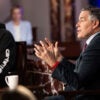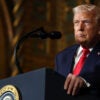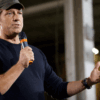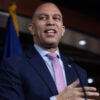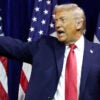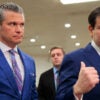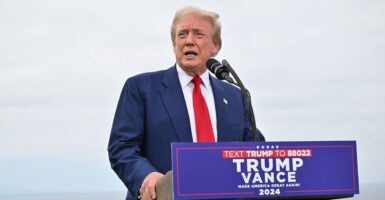The second assassination attempt against former President Donald Trump while he was golfing at one of his Florida courses on Sunday is forcing the United States Secret Service to further tighten security around the Republican presidential nominee and to reevaluate just how much Trump should be venturing out—whether he should continue to golf and participate in other outdoor activities, according to multiple sources in the Secret Service community.
From the information released so far, it appears that the Secret Service reacted far more aggressively and quickly Sunday than it did on July 13 when a 20-year-old shooter wounded Trump and killed a firefighter attending his rally in Butler, Pennsylvania.
But many questions remain.
Just two months after the first assassination attempt, the Secret Service is again grappling with whether it has the capacity to fully protect the former president in such a heightened threat environment and how far to restrict his movements during the final 49 days of an intense presidential campaign. Members of Trump’s protective detail reportedly were briefed recently about intensified Iranian plots to assassinate Trump in retaliation for his order to kill Iranian Gen. Qasem Soleimani in a Jan. 3, 2020, drone strike.
On July 12, the day before the first assassination attempt against Trump, the FBI arrested Asif Merchant, a Pakistani citizen with deep ties to Iran. Merchant had traveled to Iran and plotted the assassination of Trump with an Iranian handler and funding from the Islamic Revolutionary Guard Corps, Iran’s elite military forces, according to an FBI proffer, a detailed write-up of its interrogation of Merchant.
GOP Sen. Chuck Grassley obtained that document from a whistleblower and released it last week. The FBI nabbed Merchant when he was trying to hire hitmen in New York.
A video from Jan. 12, 2022, which Ayatollah Ali Khamenei, Iran’s religious and military leader, posted on his website, shows an animated scenario in which a robot drone assassinates Trump while the former president is golfing. It ends with the words, “Revenge is definite.” An earlier video that Khamenei posted three days after Soleimani’s death enacts Trump’s assassination during a speech, threatening that “If you begin the war, we will end the war.”
Other more specific security questions remain about whether the Secret Service deployed drones to help surveil the golf course on Sunday after failing to do so at the Butler rally and why it didn’t place better security along the perimeter of both venues.
Multiple sources in the Secret Service community are describing Sunday’s golfing event at Trump National Golf Club in West Palm Beach as an OTR, which translates to “off the record” in Secret Service parlance.
In Secret Service parlance, an OTR refers to activities or events that are not listed in the internal schedule and are more spontaneous in nature and those in which the Secret Service team that protects Trump has to jump into action to do its best to protect him on short notice.
The campaign had not made the Republican nominee’s schedule public after a West Coast swing that culminated in Las Vegas the night before, though Trump is known to frequent the golf course on weekends.
Trump’s Secret Service detail may have had access to an array of security assets to help protect him at a golf course he regularly plays, but for OTR events, it depends on what headquarters have approved for Trump and what special agents and Uniformed Division officers are available that particular day.
“So more or less, you generally don’t have a massive footprint with an OTR,” one source told RealClearPolitics. “You kind of just show up and then you own whatever happens that day.”
What happened on Sunday was that Trump once again narrowly escaped an attempted assassination. This time, the Secret Service appeared to act decisively and professionally. At a Sunday afternoon press conference, Palm Beach County Sheriff Ric Bradshaw recounted how a Secret Service special agent saw the barrel of an AK-47-style rifle poking out from a fence in the brush while the Republican presidential nominee was walking the course just 300-500 yards away.
The suspect, who anonymous local law enforcement authorities identified as Ryan Wesley Routh, had hung two backpacks full of ceramics and a GoPro camera on a chain-link fence where he was positioned. Sources tell RealClearPolitics that the ceramics were apparently intended to help shield the shooter from return fire.
“Soft body armor like what we wear, and police wear, can only stop pistol rounds,” one of the sources said. “In order to stop rifle rounds, which travel MUCH faster, you need rifle plates like the military wear or SWAT teams wear.”
“I believe that the suspect hanging two backpacks on the fence filled with ceramic tile was his attempt to provide himself a somewhat protected firing position,” the source added.
Bradshaw said the suspect ditched his weapon and fled in a Nissan SUV when agents opened fire. The sheriff credited a witness with taking a photo of the departing vehicle and its license plate number, which enabled police to find the suspect on the freeway. When taken into custody, Routh reacted calmly and didn’t say anything, the sheriff recalled.
Unlike Thomas Matthew Crooks, the alleged gunman in the first assassination attempt, Routh has a robust social media presence, repeatedly expressing his willingness to “fight and die” in Ukraine in social media posts.
A 58-year-old former construction worker from Greensboro, North Carolina, Routh also wrote what appears to be a scathing diatribe against Trump in a June 11, 2020, post on X replete with misspellings and grammar mistakes.
@realDonaldTrump While you were my choice in 2106, I and the world hoped that you President Trump would be different and better than the candidate, but we all were greatly disappointment and it seems you are getting worse and devolving; are you retarded; I will be glad when you gone.
The golf course was partially shut down as Trump played Sunday. It’s unclear whether the Secret Service utilized a drone to assist its surveillance of the golf course. Sources in the Secret Service community have told RealClearPolitics that the agency is quickly trying to bolster its drone program after agency leaders had resisted doing so for years.
Crooks flew a drone just hours before the rally started, and he opened fire on Trump and the crowd from a rooftop an estimated 350 yards away. Acting Secret Service Director Ronald Rowe, in Senate testimony on July 30, acknowledged that local law enforcement had offered the agents a drone to help surveil the Butler rally but that the Secret Service rejected the offer.
Agency leaders had resisted the widespread use of drones dating back to 2016 when some divisions were working with the Defense Advanced Research Projects Agency, a research and development agency of the Defense Department, to develop an unmanned aerial vehicle program. But Secret Service leaders rejected the push for a comprehensive implementation of drones, although the agency does have a counter-drone system that can disable other entities’ drones that appear in the sky.
Rowe confirmed that the reason the counter-drone system was not deployed at Butler earlier in the day when Crooks flew his drone was because of internet connectivity issues.
“On this day in particular, because of the connectivity challenge … there was a delay,” he said.
The failure to use drones or the counter-drone system has “cost me a lot of sleep,” Rowe said.
Moving forward, Rowe pledged to upgrade the agency’s technology to ensure interoperability in communications with local law enforcement to help better secure future events. He also announced a new research and development division and formed a task force to improve technology co-chaired by Secret Service supervisors in the Protective Division in partnership with the Cybersecurity and Infrastructure Security Agency, which helps coordinate cybersecurity and infrastructure programs across all levels of government.
Before that fateful day in July, Trump was treated like a typical former president and repeatedly denied additional security assets by agency leaders who admitted they were abiding by outdated protocols. Those denials, which took place over two years, occurred even though Trump is the current Republican presidential nominee as well as one of the most divisive political figures in the world—and a man who undoubtedly faces the biggest threats of anyone the Secret Service is supposed to protect.
Multiple sources have said Rowe was directly involved in the decisions to deny security assets to the Trump detail for years, although Rowe denied doing so when he testified before the Senate.
Agency leaders have since ramped up security for Trump to a level just shy of a sitting president, according to several sources in the Secret Service community. While he lacks the military assets such as Marine One, the presidential helicopter, and Air Force One, the presidential jet, and a military aide, the Secret Service after the first assassination attempt added multiple countersniper teams to guard Mar-a-Lago, as well as a Counter Assault Team, a special operations unit that provides tactical support to the entire Trump special agent detail, and Counter Surveillance Units. How many of these assets were utilized during the golf outing is also unknown.
“He is not the sitting president,” Bradshaw said during Sunday’s press conference. “If he was, we would have this entire golf course surrounded.”
The essential question to determine whether the Secret Service was providing the most robust protection for Trump after a previous assassination attempt roughly two months ago is whether Trump had the exact same assets on the golf course as President Joe Biden does when he plays in Wilmington, Delaware, according to two sources in the Secret Service community.
Although the Secret Service didn’t immediately respond to that question Sunday night, Bradshaw’s comments call into question whether the lessons of Butler have been implemented. Several sources said that when Biden golfs in Delaware, the service implements a highly fortified perimeter, along with countersniper teams and agents sweeping the woods with canines, among other security measures.
Still, Trump and other protectees, including presidents and first ladies, have a lot of leeway in taking the risk to mingle with the public on short notice to their Secret Service detail. President Joe Biden and first lady Jill Biden opted for an “OTR” visit to a local Waffle House in the Atlanta area the morning after the president’s June 24 debate against Trump that led to his forced ouster from leading the Democratic presidential ticket and the party tapping Vice President Kamala Harris to replace him.
Others in the Secret Service community say that while Trump was president, his protective detail treated every weekend golf outing Trump took to his own golf club near Sterling, Virginia, as an OTR. The Secret Service has far more control and even veto power over rallies and event sites that it deems too dangerous.
The Secret Service could lock down the entire golf course when Trump plays, but the former president has previously told his detail that he wanted more interaction with his golf club guests—and locking it down is obviously bad for business as well.
According to two sources in the Secret Service community, the agency provided trucks to help protect secure sites at the Butler rally, but Trump’s campaign found them unsightly and opted not to use them.
But because Trump regularly golfs on the weekends at his own courses, the Secret Service is losing strategic advantages, Dan Bongino, a former Secret Service special agent and a popular conservative commentator, warned on X Sunday afternoon.
“Looks like it was an OTR (off the record) movement for President Trump,” Bongino said in a post. “Security is handled differently for OTR movements, and this policy may have to change moving forward. The Secret Service loses any element of surprise with an OTR movement with President Trump because he’s so recognizable, and his in-town schedule can be predictable.”
While Bradshaw was quick to praise the Secret Service, especially the agent who engaged with the failed assassin on Sunday, others were more hesitant to sing their praises.
“Be cautious of early details about who shot first,” Bongino also warned Sunday, responding to reports that the Secret Service fired off the shots but didn’t hit the suspect, who then fled into the woods.
The Secret Service also has been under scrutiny from lawmakers on Capitol Hill who have called for someone to be fired after July 13 failures. In the face of withering and bipartisan congressional criticism, Secret Service Director Kimberly Cheatle resigned, but so far, no one else has been fired.
Michael Plati, the assistant director of the Office of Protective Operations, who is charged with signing off on the security allocations and denials, several weeks ago internally announced plans to retire. His departure could come as early as this week.
Sources last week said Rowe and other agency leaders “encouraged” Plati to retire, while several rank-and-file special agents took exception to reports that Plati was being forced out. They argued that Rowe and Cheatle were behind the denials of additional assets to Trump—that Plati was simply following orders.
Secret Service leaders have placed several members of the Pittsburgh Field Office on work-from-home status while the investigation proceeds. Other sources said a special agent for the detail assigned to Trump was also on leave, but one source told RealClearPolitics Sunday that the agent is now back on the job.
The decision to put more agents from the Pittsburgh Field Office on leave than the Trump detail has stirred resentment in Secret Service field offices across the country, according to two sources in the Secret Service community.
The field office agents worry that Pittsburgh is “taking the fall” for the mistakes at Butler and argue that several members of the detail assigned to Trump are also at fault and should also be forced onto work-from-home status until the internal investigation into who is responsible for the July 13 failures concludes.
The Pittsburgh Field Office staff weren’t briefed on the acute Iranian threat Trump was facing just before the Butler rally, according to these two sources, but the FBI told Secret Service headquarters, who shared the news with the Trump detail.
A New York Times report on Sunday also mentioned a possible Iranian connection to Routh. The reporter, Thomas Gibbons-Neff, wrote a piece recalling his experience interviewing Routh in Washington last year. Routh was apparently there to speak to members of Congress about his support for the Ukraine war and efforts to recruit Afghan fighters defecting from the Taliban to fight in Ukraine.
“When I talked to Mr. Routh in March of last year, he had compiled a list of hundreds of Afghans spread between Iran, Pakistan, and Afghanistan whom he wanted to fly, somehow to Ukraine,” Gibbons-Neff said, noting that he didn’t know if the meeting with the congressmen ever occurred.
Gibbons-Neff explained that he had met Routh through an old colleague and friend from Kabul, Afghanistan.
“Through the strange nexus of combatants as one war ended and another began, he had learned of Mr. Routh through a source of his in Iran, a former Afghan special operations soldier who was trying to get out of Iran and fight in Ukraine,” the reporter said.
“(Anything, even war, was better than the conditions in Iran for Afghans after the Taliban took Kabul in August of 2021),” Gibbons-Neff asserted, describing Routh as “exasperated and a little suspicious over the phone.”
By the time he got off the phone with Routh, Gibbons-Neff said it was clear to him “he was in way over his head.”
“He talked of buying off corrupt officials, forging passports, and doing whatever it takes to get his Afghan cadre to Ukraine, but he had no real way to accomplish his goals,” he wrote.
“Like many of the volunteers I interviewed, he fell off the map again. Until Sunday.”
This article was originally published by RealClearPolitics and made available via RealClearWire
